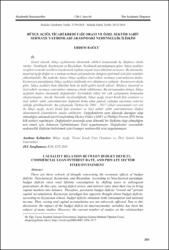| dc.contributor.author | Bağcı, Erdem | |
| dc.date.accessioned | 2023-12-18T11:07:08Z | |
| dc.date.available | 2023-12-18T11:07:08Z | |
| dc.date.issued | 2018 | en_US |
| dc.identifier.issn | 2148-5933 | |
| dc.identifier.uri | https://hdl.handle.net/11363/6737 | |
| dc.description.abstract | Bütçe açığının, makro
ekonomik değişkenler üzerindeki etkisi bir çok çalışmanın konusunu
oluşturmuştur. Ancak, literatür incelendiğinde, bütçe açığı, ticari kredi faiz
oranları ve özel sektör sabit yatırımlarının ilişkisini konu alan güncel
çalışma sayısının yetersiz olduğu görülmektedir. Bu çalışmada, Türkiye'de 2001
- 2017 yılları arasındaki verileri kapsayan veri seti ile bütçe açığı, ticari
kredi faiz oranları ve özel sektör sabit yatırımlarının ilişkisi ekonometrik
yöntemlerle analiz edilmiştir. Değişkenlerin aynı düzeyde durağan olup olmadığını anlamak için Genişletilmiş
Dickey Fuller (ADF) ve Phillips Perron (PP) birim kök testleri yapılmıştır.
Değişken arasında uzun dönemli bir ilişki olup olmadığını test etmek için
Johansen Eşbütünleşme Testi uygulanmıştır. Değişkenler arasındaki nedensellik
ilişkisini belirlemek için Granger nedensellik testi uygulanmıştır. | en_US |
| dc.description.abstract | There are three
schools of thought concerning the economic effects of budget deficits:
Neoclassical, Keynesian, and Ricardian. According to Neoclassical paradigm,
budget deficits raise total lifetime consumption by shifting taxes to
subsequent generations. In this case, saving deficit arises, and interest rates
must then rise to bring capital markets into balance. Therefore, persistent
budget deficits "crowd out" private capital accumulation. Keynesian
paradigm has opposite thought about budget deficits. according to Keynesian
school, budget deficits stimulate both consumption and national income. Thus,
saving and capital accumulation are not adversely affected. Due to this
discussion, the impact of the budget deficit on macroeconomic variables has
been the subject of many studies. However, the current number of studies on the
relationships between budget deficit, commercial loan interest rates and
private sector fixed investments are inadequate. In this study, the relationships
between budget deficit, commercial loan interest rate, and private sector fixed
investment are analyzed by econometric methods and by using data covering
2001-2017 in Turkey. Dickey Fuller (ADF) and Phillips Perron (PP) unit root
tests were performed to determine whether the variables are stable at the same
level or not. The Johansen Cointegration Test was applied to test for a
long-term relationship between the variables. The Granger Causality Test was
applied to determine the causality relationship between the variables. | en_US |
| dc.language.iso | tur | en_US |
| dc.publisher | Hüzeyfe Süleyman Arslan | en_US |
| dc.rights | info:eu-repo/semantics/openAccess | en_US |
| dc.subject | Bütçe Açığı | en_US |
| dc.subject | Ticari Kredi Faiz Oranları ve Özel Sektör | en_US |
| dc.subject | Sabit Yatırımları | en_US |
| dc.subject | Budget Deficit | en_US |
| dc.subject | Commercial Loan Interest Rate | en_US |
| dc.subject | Private Sector Fixed Investment | en_US |
| dc.title | Bütçe Açığı, Ticari Kredi Faiz Oranı ve Özel Sektör Sabit Sermaye Yatırımları Arasındaki Nedensellik İlişkisi | en_US |
| dc.title.alternative | Causality Relation Between Budget Deficit, Commercial Loan Interest Rate, and Private Sector Fixed Investment | en_US |
| dc.type | article | en_US |
| dc.relation.ispartof | Akademik Hassasiyetler | en_US |
| dc.department | İktisadi İdari ve Sosyal Bilimler Fakültesi | en_US |
| dc.authorid | https://orcid.org/0000-0003-1856-3517 | en_US |
| dc.identifier.volume | 5 | en_US |
| dc.identifier.issue | 10 | en_US |
| dc.identifier.startpage | 203 | en_US |
| dc.identifier.endpage | 217 | en_US |
| dc.relation.publicationcategory | Makale - Ulusal Hakemli Dergi - Kurum Öğretim Elemanı | en_US |
| dc.contributor.institutionauthor | Bağcı, Erdem | |

















